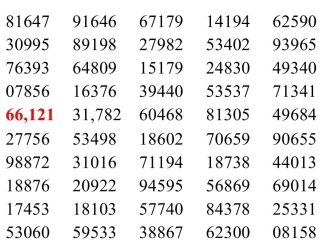Multiple Choice
Five-digit random numbers are used to simulate scores on each hole in an 18-hole round c The correspondence between the random numbers and scores on each hole is chosen to bc follows.
Use the following portion of a random numbers table starting with the highlighted numbe and determine how many holes the simulated golfer made par or better (i.e., how many holes-in-one, eagles, birdies, and pars were obtained in the 18 holes) . Use the highlightec as the score on the first hole; work down a column moving from left to right, column to : needed.
olf. number
Lumn as
A) 13
B) 10
C) 12
D) 11
Correct Answer:

Verified
Correct Answer:
Verified
Q2: The survey question "Do you feel that,
Q3: A researcher is using a random numbers
Q4: Why would researchers want to use a
Q5: The PAC-10 Conference consists of ten
Q6: If a third of a population is
Q7: Sampling methods often use random numbers to
Q8: In many women's tennis matches they
Q9: A flip of a fair coin
Q10: A pollster wanted to determine how much
Q11: Which of the following is not a